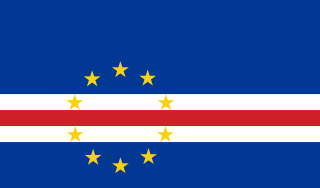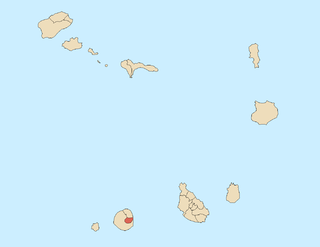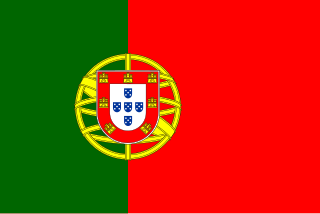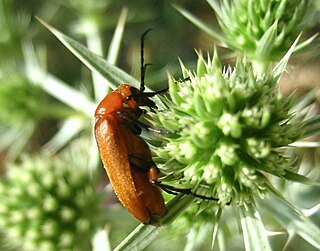
The recorded history of Cape Verde begins with Portuguese discovery in 1456. Possible early references go back around 2000 years.

The Cape Verde warbler is an Old World warbler in the genus Acrocephalus. It is also known as the Cape Verde cane warbler or Cape Verde swamp warbler, and in Creole as tchota-de-cana, chincherote,. It breeds on Santiago, Fogo, and São Nicolau in the Cape Verde Islands. It previously bred on Brava. This species is found in well-vegetated valleys, avoiding drier areas. It nests in reedbeds, two to three eggs being laid in a suspended nest.

Pico do Fogopronounced [ˈpiku du ˈfoɡu] is the highest peak of Cape Verde, rising to 2,829 metres (9,281 ft) above sea level. It is an active stratovolcano lying on the island of Fogo. The main cone last erupted in 1680, causing mass emigration from the island. A subsidiary vent erupted in 1995. The only deadly eruption was in 1847 when earthquakes killed several people.

Mosteiros is a concelho (municipality) of Cape Verde. Situated in the northeastern part of the island of Fogo, it covers 19% of the island area, and is home to 26% of its population. Its seat is the city Mosteiros (Igreja). Its population was 9,524 at the 2010 census, and its area is 89.45 km2.

Santa Catarina do Fogo is a concelho (municipality) of Cape Verde. Situated in the southeastern part of the island of Fogo, it covers 32% of the island area, and is home to 14% of its population. Its seat is the city Cova Figueira. The Municipality of Santa Catarina do Fogo was created in 2005; before 2005, it was a parish of the Municipality of São Filipe.

Cova Figueira is a city in the southeastern part of the island of Fogo, Cape Verde. In 2010 its population was 1,230, making it the most populated place in the municipality. It is situated 22 km east of the island capital São Filipe. Since 2005, it serves as the seat of Santa Catarina do Fogo Municipality. Its elevation is 480 meters above sea level. The volcano Pico do Fogo is 7.7 km to the northwest. Nearby places include Figueira Pavão in the southwest, Mãe Joana and Estância Roque in the west and Tinteira in the north. Cova Figueira was elevated to a city in 2010.
The Fogo Premier Division is a tier-2 regional championship played in Fogo Island, Cape Verde. The competition are organized by the Fogo Regional Football Association. The winner of the championship plays in the Cape Verdean football Championships of each season while the last placed club relegates and participates in the Second Division in the following season.

Cabeça Fundão is a settlement in the southern part of the island of Fogo, Cape Verde and sits on the foot of the mountain rim of Bordeira. It is situated 16 km east of the island capital São Filipe. In 2010 its population was 177. The village is located on the road from Achada Furna to Chã das Caldeiras (EN3-FG05). Its elevation is about 1,570 meters. Cabeça Fundão lies directly south of the Fogo Natural Park.

Ponta Verde is a town in the northwestern part of the island of Fogo, Cape Verde. In 2010 its population was 1,072. It is situated 11 km northeast of the island capital São Filipe.

Mosteiros is a city in the northeastern part of the island of Fogo, Cape Verde. It is situated on the coast, 24 km northeast of the island capital São Filipe. It is the seat of the Mosteiros Municipality and of the civil parish Nossa Senhora da Ajuda. At the 2010 census its population was 4,124, making it the island's second most populated place.

Fogo Natural Park, on the island of Fogo, is one of ten "natural parks" in the country of Cape Verde. The protected area is 84.69 km2 (32.70 sq mi), which is 17.8% of the total area of the island. 50% of the park lies within the municipality Santa Catarina do Fogo, 28% in municipality of Mosteiros and 22% in São Filipe. The natural park is situated in the interior of the island, and covers the volcano Pico do Fogo, its crater and crater rim (Bordeira) and the forest of Monte Velha. The volcano is active; the most recent eruption was in 2014-15.

Cape Verde was a colony of the Portuguese Empire from the initial settlement of the Cape Verde Islands in 1462 until the independence of Cape Verde in 1975.
Umbilicus schmidtii is a flowering plant in the family Crassulaceae. The species is endemic to Cape Verde. It is listed as endangered by the IUCN.

Museu Municipal de São Filipe is a museum located in the historic centre of São Filipe, on the island of Fogo, Cape Verde. It is located in a sobrado, a colonial town house. The museum was opened on December 13, 2008, by the town president Eugênio Miranda da Veiga.
Chioninia fogoensis is a species of skink in the Scincidae family. It is endemic to the island of Santo Antão, Cape Verde. The species was named by Arthur William Edgar O'Shaughnessy in 1874. After revision of the species in 2010 based on molecular evidence, it no longer includes the skinks of São Nicolau, nor of the original type locality Fogo.

Zonitis is a genus of blister beetles in the family Meloidae. The genus was named and described by Johan Christian Fabricius in 1775.

The island of Fogo in Cape Verde in the westcenter of the Sotavento Islands is home to several teams and clubs. The major professional clubs is Botafogo, semi-pro teams includes Académica do Fogo and Vulcânicos, the remainder including the youth club Juventude and Spartak d'Aguadinha are amateur. The football competition was the third along with Sal to have its own first held in 1976 after the nation's independence. From its foundation to 2005, the island had a single league of each sport, it is currently divided into two divisions, the Premier and the Second.
The Fogo Island Opening Tournament, is an opening tournament competition played during the season in the island of Fogo, Cape Verde The competition is organized by the Fogo Regional Football Association. The winner with the most points is the winner.
The 2017 Santiago South Super Cup was the annual and a single knockout match in the island of Fogo featuring the champion of the 2016-17 Premier Division Vulcânicos and the winner of the cup competition Académica do Fogo. The match also formed a part of the Vulcânicos–Académica do Fogo rivalry.














